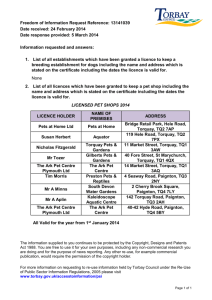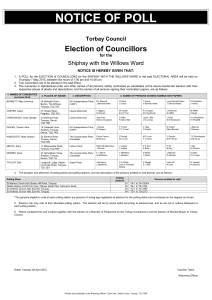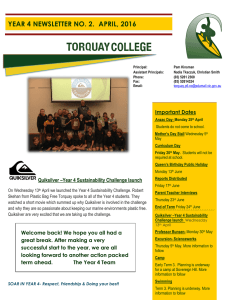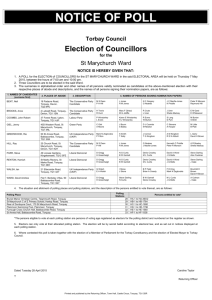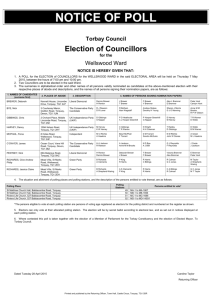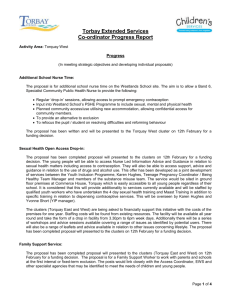The Hamlyn Legacy - College of Social Sciences and International
advertisement
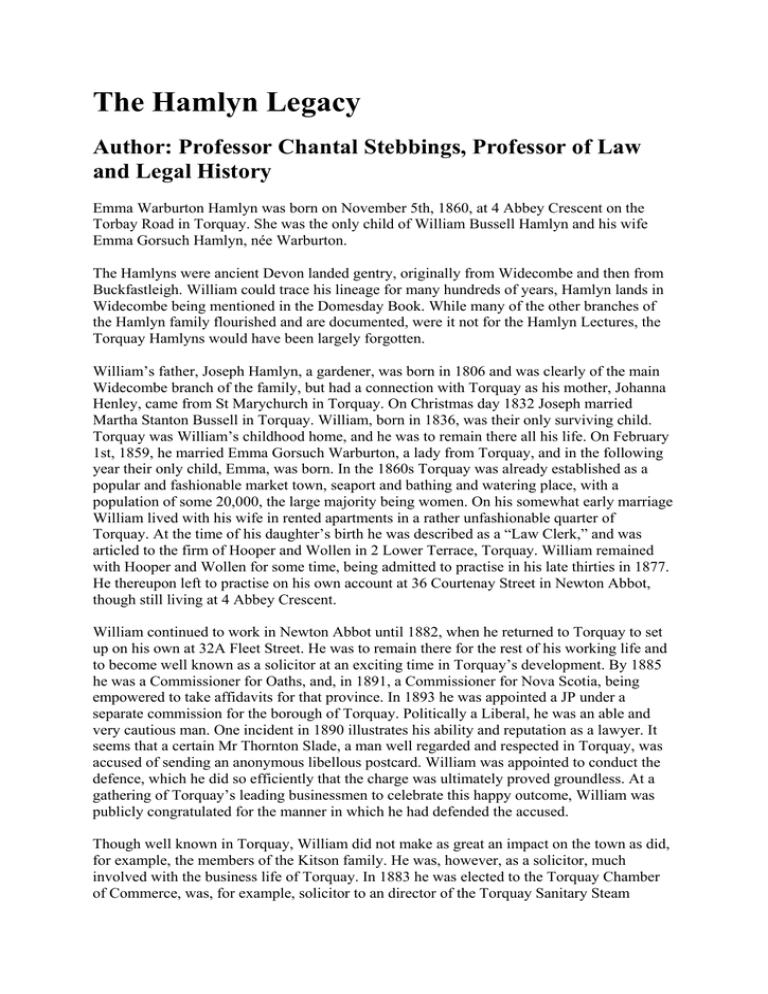
The Hamlyn Legacy Author: Professor Chantal Stebbings, Professor of Law and Legal History Emma Warburton Hamlyn was born on November 5th, 1860, at 4 Abbey Crescent on the Torbay Road in Torquay. She was the only child of William Bussell Hamlyn and his wife Emma Gorsuch Hamlyn, née Warburton. The Hamlyns were ancient Devon landed gentry, originally from Widecombe and then from Buckfastleigh. William could trace his lineage for many hundreds of years, Hamlyn lands in Widecombe being mentioned in the Domesday Book. While many of the other branches of the Hamlyn family flourished and are documented, were it not for the Hamlyn Lectures, the Torquay Hamlyns would have been largely forgotten. William’s father, Joseph Hamlyn, a gardener, was born in 1806 and was clearly of the main Widecombe branch of the family, but had a connection with Torquay as his mother, Johanna Henley, came from St Marychurch in Torquay. On Christmas day 1832 Joseph married Martha Stanton Bussell in Torquay. William, born in 1836, was their only surviving child. Torquay was William’s childhood home, and he was to remain there all his life. On February 1st, 1859, he married Emma Gorsuch Warburton, a lady from Torquay, and in the following year their only child, Emma, was born. In the 1860s Torquay was already established as a popular and fashionable market town, seaport and bathing and watering place, with a population of some 20,000, the large majority being women. On his somewhat early marriage William lived with his wife in rented apartments in a rather unfashionable quarter of Torquay. At the time of his daughter’s birth he was described as a “Law Clerk,” and was articled to the firm of Hooper and Wollen in 2 Lower Terrace, Torquay. William remained with Hooper and Wollen for some time, being admitted to practise in his late thirties in 1877. He thereupon left to practise on his own account at 36 Courtenay Street in Newton Abbot, though still living at 4 Abbey Crescent. William continued to work in Newton Abbot until 1882, when he returned to Torquay to set up on his own at 32A Fleet Street. He was to remain there for the rest of his working life and to become well known as a solicitor at an exciting time in Torquay’s development. By 1885 he was a Commissioner for Oaths, and, in 1891, a Commissioner for Nova Scotia, being empowered to take affidavits for that province. In 1893 he was appointed a JP under a separate commission for the borough of Torquay. Politically a Liberal, he was an able and very cautious man. One incident in 1890 illustrates his ability and reputation as a lawyer. It seems that a certain Mr Thornton Slade, a man well regarded and respected in Torquay, was accused of sending an anonymous libellous postcard. William was appointed to conduct the defence, which he did so efficiently that the charge was ultimately proved groundless. At a gathering of Torquay’s leading businessmen to celebrate this happy outcome, William was publicly congratulated for the manner in which he had defended the accused. Though well known in Torquay, William did not make as great an impact on the town as did, for example, the members of the Kitson family. He was, however, as a solicitor, much involved with the business life of Torquay. In 1883 he was elected to the Torquay Chamber of Commerce, was, for example, solicitor to an director of the Torquay Sanitary Steam Laundry Co. Ltd for over raders. His appointment as JP brought him entry to the civic life of Torquay, and he is seen attending functions such as Mayors’ Luncheons and civic funerals, and undertaking tasks such as organizing expressions of goodwill towards town servants on their retirement or appointment elsewhere. As if to reflect his growing success, in 1890 William moved his family to a more fashionable quarter of Torquay, to a large late Victorian villa in Barrington Road, Ilsham, known as Kintyre but renamed Widecombe Cot, presumably in view of his family’s ancient home. William, his wife and his daughter, were all to remain there until their deaths. The Hamlyns were Methodists, and this would undoubtedly have greatly influenced most aspects of their lives. Emma’s grandparents were Wesleyans, and William’s birth is appropriately registered. Emma knew her paternal grandparents well, for her grandfather died in July 1893 and her grandmother three years later, when Emma was in her early thirties. In her will she expressed the wish that her grandparents’ graves in the Torquay Cemetery be maintained. It is possible that she knew her maternal grandparents as well; one bequest in her will was of two glasses bearing the names of John and Martha Stanton, possibly her mother’s parents. Joseph and William were both very active Methodists, solicitors generally being well represented in Methodist circles. One of the very few references to Mrs Hamlyn is in the context of a social event of the Wesleyan church. William’s greatest contribution to Torquay stemmed from his Methodism, for he and his wife were much involved with the Torquay British Schools. These were voluntary nonconformist schools, the result of a movement which began in the early nineteenth century. There were three such schools in Torquay during the latter part of the century, and it is very likely that Emma attended one of them. One of these schools was built at the junction of Rock Road and Abbey Road, next to the Hamlyns’ Chapel, and this one would seem the most probable. In 1890 William was elected president, and it is clear that he had long been well-known in connection with the schools. The meeting at which the election took place was confident that Mrs Hamlyn would make a good “presidentess.” These schools closed in 1894, essentially through lack of funds. The Sunday schools attached to the Chapels survived, and Emma probably attended the one attached to the Rock Road Wesleyan Chapel. Her father was the school librarian for a number of years, and it is possible that her grandfather was Superintendent. The Rock Road Chapel moved to new premises in Union Street in 1879, and the Hamlyns naturally followed. The extent of Emma’s Methodism is unknown, but the indications are that she was not as devout as her father and grandfather. She was never active in Methodist circles in Torquay. William, a modest man of a very retiring disposition was, it seems, a cultured man. He became a proprietary member of the Torquay Natural History Society in 1877, a society formed primarily for the purpose of purchasing books on natural history, but meeting monthly and holding lectures on a wide range of topics which were delivered at the Museum in Torquay. The Museum was in Babbington Road, close to Widecombe Cot. He never, however, became one of its officers. William retired from the society in 1912 or 1913, and was not sufficiently involved with the society for it to record his death. In 1893 William was elected a member of the distinguished and influential Devonshire Association, and attended its meetings. Ultimately ill health caused William to give up his work. He sold his practice to another Torquay firm of solicitors, Kitsons and Co., which firm is still extant today. He remained at Widecombe Cot, leading a quiet and retired life. He was already in poor health when his wife died in 1913, and he himself died at Widecombe Cot on November 16th 1919, aged over eighty. By his will he left all his property to his daughter absolutely. There is no record of Emma’s activities from the time of her father’s death. It is known that she remained at Widecombe Cot, but nothing more. She is remembered as being a cultured woman, and a fine pianist, but she seems to have played no part in the social, literary, musical or artistic life of Torquay. She was not a member of the Torquay Natural History Society, and does not seem to have been active in the Torquay Debating Society or in any of the local political societies. Though not wealthy, Emma was clearly of comfortable means, and during her father’s lifetime it seems that she travelled extensively in Europe and Egypt. It was usual for solicitors such as William to lend money out on mortgage, and certainly when Emma died her estate was largely comprised of such investments. There is no surviving evidence to support her travels, other than it is known that she was frequently absent from her home for a number of months at a time. When she was at home she was generally in the company of one of a circle of lady visitors, some of whom were clearly foreign. Certainly in the latter years of the nineteenth century, tourism was fast increasing and it was possible to travel widely from Torquay. It is reasonable to surmise that in the latter years of her life, Emma had ceased to travel. It is believed that she made full use of her local library, borrowing books on the subjects she mentioned in her will. She spent her last years at Widecombe Cot, taking no part in public affairs, and leading a very retired life. It would seem she lived alone, with intermittent domestic help. She died at Widecombe Cot, the house where she had spent most of her life, on September 1st 1941, aged eighty. We learn more of Emma from the provisions of her will than from any surviving record of her activities during her lifetime. She made a number of specific bequests, namely a clock which had belonged to her grandfather, to Joseph Warburton, and some antique pieces to the Torquay Natural History Society, and a number of specific legacies to her executors and certain other individuals. Her estate was valued at £19,521 gross. Emma appointed three executors. The first was Joseph Roberts Warburton, a retired Principal of the Board of Education, who lived in Walton on Thames in Surrey. He and Emma shared a common grandfather, her mother’s father, and it seems he was her closest living relative. The second was Edmund Ball, KBE, Assistant Auditor at the India Office in London from 1934 to 1943. He was some twenty years younger than Miss Hamlyn, and was the son of one of her father’s barrister friends. The third was Sidney Keith Coleridge of Loughborough, an Inspector of Taxes who was the grandson of her father’s friend, George Adams Goss.In terms which it seems were her own, and resisting all attempts by her solicitors to amend them, she bequeathed the residue of her estate to her executors as trustees “upon trust to apply the income of the Trust Fund in the futherance by lectures or otherwise among the Common People of this Country of the knowledge of the Comparative Jurisprudence and the Ethnology of the Chief European countries including our own and the circumstances of the growth of such Jurisprudence to the intent that the Common People of our Country may realise the privileges which in law and custom they enjoy in comparison with other European Peoples and realising and appreciating such privileges may recognize the responsibilities and obligations attaching to them.” Miss Hamlyn’s solicitors had urged her to amend this passage because they felt that the words might necessitate an application to the court in order to determine their true meaning and the implementation of the trust. This is indeed what happened. The wording was vague, and after the will had been proved, counsel’s opinion was sought. The main question to be resolved at that stage was whether the bequest was void for uncertainty on the basis that the objects, “the Common People of this Country,” was too wide and uncertain a class. However, the rules of certainty of objects in the case of charitable trusts is not as strict as for private trusts, and if the trust were charitable, the class would not be regarded as too vague. In 1942 Mr Hubert Rose advised that the bequest was a good charitable gift for the advancement of education, “the Common People” meaning the public generally, but that it would be desirable for the court to approve a scheme to clarify certain points in the will. Accordingly the trustees applied to the Chancery Division of the High Court, which in 1948 finally approved a scheme for the administration of the trust. The scheme closely followed the wording of Miss Hamlyn’s will, with “my country” being taken to mean the United Kingdom. The capital of the trust was some £15,000, consisting mostly of mortgages secured on freehold and leasehold properties. Indeed it is seen that Miss Hamlyn had been making such investments until just a few years before her death.The scheme laid down by the court provided that the trustees were to be the Principal for the time being of the University College of the South West, now the Vice-Chancellor of the University of Exeter, and he was to be an ex officio trustee; the trustees of Miss Hamlyn’s will; and the representatives of the Universities of London, Leeds (replacing the University of Durham, which declined), Glasgow, Belfast and Wales. This would have the effect of representing the trust throughout the United Kingdom. The trustees’ first meeting was in London in 1949, some eight years after Miss Hamlyn’s death. The reason for the success of the trust lies in the policy of the early trustees, and the drive and energy of Professor Murray, the Principal of the University College of the South West, and the other academic trustees. Even before counsel’s opinion had been sought, Miss Hamlyn’s solicitors had made contact with Professor Murray, who proposed that the College should be the seat of the endowment. It was Hubert Rose who suggested that that might be too limited, that other universities in other parts of the country be involved as well.It was decided when the trust was established that its objects could be best achieved by means of lectures by eminent lawyers and their subsequent publication and distribution, and it is the consistently high quality of the speakers which has ensured the continuing success and high reputation of the Hamlyn Lectures. The first lecture, Freedom under the Law, was delivered at London University by Lord Denning and set the standard for the subsequent lectures. Similar issues of fundamental importance to the Common Law were addressed, but the spirit of the Hamlyn Trust was apparent in the lectures assessing the contribution of English law to Indian, South African and Canadian law. Scotland and other European countries have not been forgotten. Emma Hamlyn remains something of an enigma. The very sparse documentation suggests she led a quiet, relatively uneventful, and very private life, an unmarried Victorian lady with no more than a comfortable background, largely self-taught, and moving in modest social circles. It is thus all the more surprising and admirable that she should have founded the trust which now provides for the highly regarded and prestigious Hamlyn Lectures. It is said that she studied law, but no evidence has been found to support this. It seems likely that she founded the trust in memory of her father, though she does not say so, and in that sense it is not inappropriate that more is known of her father’s life than her own. It would seem that she was an intelligent and intellectually curious woman of strong personality, who, in view of her father’s profession, took an interest in the legal systems of the countries and cultures she visited, and that that interest was sufficiently strong, and she sufficiently determined and imaginative, to create a trust which would ensure that her interest endured long into the future. ©Chantal Stebbings

